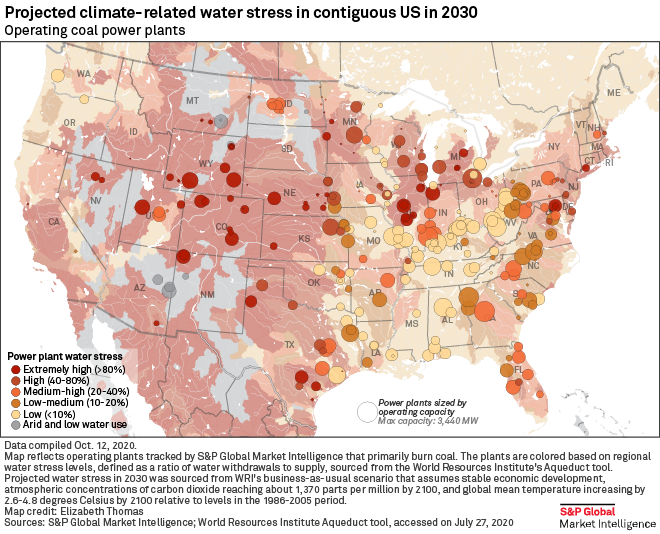S&P Global Offerings
Featured Topics
Featured Products
Events
S&P Global Offerings
Featured Topics
Featured Products
Events
S&P Global Offerings
Featured Topics
Featured Products
Events
Featured Products
Ratings & Benchmarks
By Topic
Market Insights
About S&P Global
Corporate Responsibility
Culture & Engagement
Investor Relations
Featured Products
Ratings & Benchmarks
By Topic
Market Insights
About S&P Global
Corporate Responsibility
Culture & Engagement
Investor Relations
S&P Global Offerings
Featured Topics
Featured Products
Events
Language

Climate change is expected to magnify water-related risk to industries and societies. Warmer seas, heavier rains, longer droughts, and other extreme weather situations caused by global warming will threaten the energy industry, especially nuclear, coal, and hydropower generation. Other industries will also have to prepare for a more erratic relationship with water, including mining and telecoms.
Published: October 30, 2020
As global warming climbs and humanity's water consumption increases, nuclear and fossil-fueled power plants that rely on freshwater for cooling may not be able to perform at their peak capacity or could be forced to shut down temporarily even as demand for their supplies for indoor cooling and other uses increase, according to researchers and industry experts.  (opens in a new tab)
(opens in a new tab)
Climate-Driven Water Issues May Increase Pressure on Miners with Tailings Dams
As climate change increases scrutiny on companies around the world, the mining sector is beginning to grapple with the substantial risk its operations present to global water supplies.
Global stakeholder organizations released new standards for tailings dams, which are engineered, massive earthen structures containing mining waste, in early August.

Many of the nation's coal-fired power plants, often heavy consumers of water resources, are in areas projected to soon face water stress due to climate change.  (opens in a new tab)
(opens in a new tab)
Key Takeaways

Operators of hydropower, one of the cleanest sources of electricity, are increasingly forced to deal with the effects of global warming.
In Norway and other regions, rising temperatures have brought more rain and are causing the glaciers feeding hydropower plants to melt faster, leading to more frequent floods and higher water inflows. At the same time, longer and more intense droughts are depleting water basins from Central Europe to the Western U.S., while the changing climate is also shifting patterns of precipitation and, in some places, remolding the landscape altogether.
Key Takeaways

COVID-19 has created a worldwide need for constant hand-washing, and that has cast a spotlight on the importance of access to clean water. The pandemic has also underscored the lack of investor interest and bankable projects for achieving a key United Nations goal on water sanitation.
In July, the U.N. announced it was accelerating plans to achieve its 2030 water objective because of the slow progress in achieving the goal. A 2019 report by the Organisation for Economic Co-operation and Development found that providing safe drinking water for all by 2030 would require annual financing of about $114 billion — approximately three times current investment levels.
The Case for Investing in Water
As the world population grows and competition for water resources between industry sectors intensifies, nations are set to experience a 40% shortfall in water by 2030.
As these demands for clean water increase, companies involved in water-related business activities stand to grow in the coming years. Allocation to water can be systematically captured by rules-based, transparent index construction. Market participants could utilize index-linked water strategies to gain exposure to water, manage water risk, express their sustainability views, or allocate as part of a broader natural resource theme.

Water crises stand to worsen as the climate changes, leading to more disputes and possible conflicts particularly when two sovereign entities compete for water from the same geological basin. That said, not all transboundary water disputes result in violent conflict, and some can be resolved via financial agreements. 
Listen: Beyond The Buzz: The Geopolitics Of Water
In the second episode of Beyond the Buzz, we delve into the topic of water – often referred to as “blue gold.” With water disputes on the rise, the World Economic Forum ranks water scarcity as more impactful than even infectious diseases in its 2020 Global Risks Report.
S&P Global Ratings’ resident water risk expert, Beth Burks, joins Corinne Bendersky and Mike Ferguson in the episode to explore the myriad risks related to water and how they may be exacerbated by climate change going forward.

